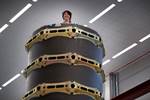Beyond Gravity delivers key products for OneWeb broadband satellite launch
CFRP dispenser, among other products, successfully deliver 36 OneWeb satellites to low Earth orbit, bringing the satellite constellation fleet to 462.
The dispenser from Beyond Gravity which deployed all OneWeb satellites. Photo Credit: ISRO, OneWeb
As a key supplier to (London, U.K.), a communications company that aims to build broadband satellite internet services, (Zürich, Switzerland) built and delivered key products — such as the carbon fiber-reinforced polymer (CFRP) satellite dispenser — which placed all OneWeb satellites in orbit during a recent launch (see “ISRO/NSIL deploys 36 OneWeb satellites in first commercial LMV-3 rocket launch”).
The dispenser functioned as an interface between the LVM-3 rocket and 36 OneWeb broadband internet satellites that were deployed from the Satish Dhawan Space Centre in India. The Beyond Gravity dispensers for OneWeb are built in Linköping, Sweden. Each dispenser has a 1.7-meter central cylinder structure and a height of 5.5 meters.
“Our dispenser is super light and includes state-of-the-art technology to safely place the satellites in orbit,” Paul Horstink, executive vice president, Division Launchers, at Beyond Gravity. “Thanks to Beyond Gravity’s flexible dispenser design, only a minor adaptation has been required to make this compatible to fly on the Indian rocket.”
Beyond Gravity also manufactured the OneWeb satellite backbone (structure) in Titusville, Fla., U.S. The structures are manufactured using an automated potting process, a production method that uses a pick-and-place machine to rapidly position special inserts filled with adhesive into the satellite structure’s sandwich panels.
The OneWeb satellites are protected from heat and cold in orbit by thermal insulation from Beyond Gravity. Photo Credit: Airbus OneWeb Satellites
Moreover, in Austria, Beyond Gravity produced the multilayer thermal insulation which protects the OneWeb satellites against the cold and heat in space from approximately -150°C to +150°C (-238°F to 302°F). The insulation consists of several layers of metal-evaporated polyimide film. Beyond Gravity in Austria also built handle equipment and transport containers.
“Our high-tech, custom satellite containers are used to transport the assembled OneWeb satellites from Florida to the launch sites,” Anders Linder, executive vice president, Division Satellites, at Beyond Gravity, adds. “The containers are equipped with a specifically designed damping system and climate control.”
See “RUAG rebrands as Beyond Gravity, boosts CFRP satellite dispenser capacity” to learn more about the company’s capabilities.
Related Content
-
Automated robotic NDT enhances capabilities for composites
Kineco Kaman Composites India uses a bespoke Fill Accubot ultrasonic testing system to boost inspection efficiency and productivity.
-
The potential for thermoplastic composite nacelles
Collins Aerospace draws on global team, decades of experience to demonstrate large, curved AFP and welded structures for the next generation of aircraft.
-
Plant tour: Collins Aerospace, Riverside, Calif., U.S. and Almere, Netherlands
Composite Tier 1’s long history, acquisition of stamped parts pioneer Dutch Thermoplastic Components, advances roadmap for growth in thermoplastic composite parts.






